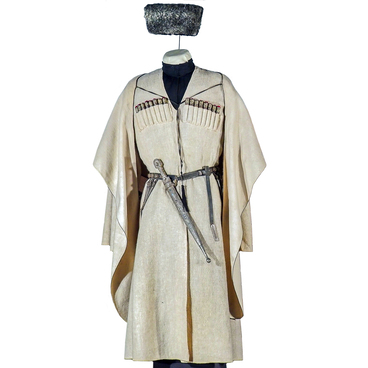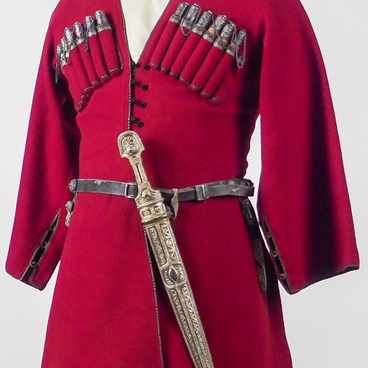The presented children’s vest - nybal – is made from purple velvet. The whole vest is decorated with an oriental colour motif not typical of traditional Adyghe ornaments. The decoration is done with a gold-brocade soutache.
A soutache is a narrow decorative braid of silk threads. Originally it was used to fringe clothes with precious stones. Later soutache embroidery began to be perceived as a separate element which seamstresses used to decorate dresses in accordance with their taste and design, and soutache turned into a decoration in its own right.
Embroidered on the back of the vest is the Tree of Life with paisley shoots on either side. The ornament on the front develops into exquisite whorls. The ornament of the whole vest is skirted with parallel soutache lines repeating the contour of the vest.
Many ornate articles of clothes were brought to Russia from the Ottoman Empire. For many centuries, beginning from the middle ages, the Circassians had had good contacts with merchants from the Mediterranean and Middle Eastern states and empires. In the 17th - early 19th century, the Ottoman-Circassian relations were based on mutually beneficial cooperation despite the fact that the Ottomans had only 5-7 coastal fortresses along the Circassian borders (Adyghe ethno-political space) to trade with the Adyghes from.
According to different sources which describe Ottoman-Circassian trade, the value of goods from the Ottoman Empire that landed in Circassia could reach up to 600,000 silver roubles. Of special demand in Circassia were monochrome silk fabrics, primarily velvet, and various textile items – golden threads, cannetille, etc.
Having analysed the ornament on the vest, the experts made a suggestion that it had come to Circassia from the Ottoman Empire in the 19th century. By that time the techniques of the Turkish seamstresses had reached such heights that their embroidery was perceived as true art, even when it was used to decorate everyday things – clothes, underwear, headdresses, belts and handkerchiefs. The most popular types of goldwork in Turkey were raised cording, soutache and cannetille (thin metal thread) embroidery.
The ornament on the vest belongs to the Turkish rococo style which appeared in the Ottoman Empire in the 19th century. Flower garlands, big acanthus leaves, paisley shoots and various whorls were characteristic of it. Exquisite decoration of this nybal goes to show that it was part of a set of children’s festive clothes.
A soutache is a narrow decorative braid of silk threads. Originally it was used to fringe clothes with precious stones. Later soutache embroidery began to be perceived as a separate element which seamstresses used to decorate dresses in accordance with their taste and design, and soutache turned into a decoration in its own right.
Embroidered on the back of the vest is the Tree of Life with paisley shoots on either side. The ornament on the front develops into exquisite whorls. The ornament of the whole vest is skirted with parallel soutache lines repeating the contour of the vest.
Many ornate articles of clothes were brought to Russia from the Ottoman Empire. For many centuries, beginning from the middle ages, the Circassians had had good contacts with merchants from the Mediterranean and Middle Eastern states and empires. In the 17th - early 19th century, the Ottoman-Circassian relations were based on mutually beneficial cooperation despite the fact that the Ottomans had only 5-7 coastal fortresses along the Circassian borders (Adyghe ethno-political space) to trade with the Adyghes from.
According to different sources which describe Ottoman-Circassian trade, the value of goods from the Ottoman Empire that landed in Circassia could reach up to 600,000 silver roubles. Of special demand in Circassia were monochrome silk fabrics, primarily velvet, and various textile items – golden threads, cannetille, etc.
Having analysed the ornament on the vest, the experts made a suggestion that it had come to Circassia from the Ottoman Empire in the 19th century. By that time the techniques of the Turkish seamstresses had reached such heights that their embroidery was perceived as true art, even when it was used to decorate everyday things – clothes, underwear, headdresses, belts and handkerchiefs. The most popular types of goldwork in Turkey were raised cording, soutache and cannetille (thin metal thread) embroidery.
The ornament on the vest belongs to the Turkish rococo style which appeared in the Ottoman Empire in the 19th century. Flower garlands, big acanthus leaves, paisley shoots and various whorls were characteristic of it. Exquisite decoration of this nybal goes to show that it was part of a set of children’s festive clothes.




